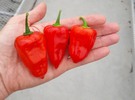Researcher shows off peppers grown using new agronomic practices and technologies. Photo provided by Kevin Crosby, Ph.D.
New hot pepper agronomic practices and technologies could help rejuvenate the U.S. market and help reduce production costs for producers.
 Kevin Crosby, Ph.D., Texas A&M AgriLife Research professor with Texas A&M College of Agriculture and Life Sciences Department of Horticultural Sciences, Bryan-College Station, is leading a team to make this happen.
Kevin Crosby, Ph.D., Texas A&M AgriLife Research professor with Texas A&M College of Agriculture and Life Sciences Department of Horticultural Sciences, Bryan-College Station, is leading a team to make this happen.
The team has received a $450,000 grant from the U.S. Department of Agriculture – Agricultural Marketing Service Specialty Crops Multi-State Program, USDA-AMS-SCMP, to develop novel solutions.
Implementing these solutions could help reverse a downward trend the U.S. hot pepper market has experienced in recent years due to foreign competition and concerns about production costs and food safety.
Reigniting the U.S. hot pepper market
The hot pepper market is volatile, Crosby said. Environmental stressors can have major effects on yield, and Mexico’s ability to supply year-round with low labor costs has caused a dependency on imports.
“When the cost of peppers is good, producers love to grow them. When it’s bad, they don’t. Harvesting is expensive, and producers can’t compete with Mexico’s prices,” he said.
Additionally, food safety continues to be a concern, as peppers are susceptible to carrying and spreading potentially harmful pathogens.
“Produce grown in the U.S. could be unaffected by an outbreak, but bad press on imports or in international markets still affects public perception,” Crosby said.
These obstacles have made many U.S. producers apprehensive about growing peppers, despite ideal growing climates in the Southwest and a rise in interest from specialty and niche markets.
But with the support from the USDA-AMS-SCMP, researchers and economists are teaming up to create a solution, identifying target windows in the market for production and sale, and developing new growing practices and cultivars that will give U.S. producers an edge on the competition.
Ag is the solution
AgriLife Research scientists explore ways to create tiered levels of spiciness in new pepper cultivars. Photo by Kevin Crosby, Ph.D.
To address producers’ apprehension, researchers are testing new growing techniques that could help pepper plants withstand extreme heat and changing climates in the Southwest.
They are also developing cultivars with unique traits that will be exclusive to U.S. producers. For instance, they’re studying potential for new habanero cultivars with different levels of spiciness and higher amounts of capsiate – a non-spicy, beneficial phytochemical.
“Habanero peppers grow extremely well in Texas, and creating tiered levels of spiciness – mild, medium and hot – will expand the market for consumption and increase consumer acceptance,” Crosby said.
Researchers are also experimenting with ways to make pepper plants yield fruit in a shorter time. This would make harvest more cost-effective and could allow producers to harvest mechanically, a cheaper alternative to manual labor.
Additionally, the team is working with a specialist in food safety and processing to better understand and address concerns about food-borne pathogens and viral diseases and to reduce the need for pesticide use.
“Imported peppers are subject to residue contamination, meaning they don’t meet U.S. food safety standards for pesticide levels,” Crosby said. “That’s why our team is looking at ways we can reduce the need for pesticides. This will be essential to creating a product that’s safe for consumption.”
Exploring alternative markets
Rather than encouraging producers to only sell directly to larger consumers like salsa plants, this study seeks to identify niche markets needing domestically grown, better quality and unique types of peppers.
They’re also looking at expanding into organic markets.
What’s next?
So far, researchers have seen promising results from initial trials in Uvalde and Weslaco. They continue to collect data on new Texas A&M AgriLife-bred pepper cultivars and commercial ones that meet grower preferences.
Source:
Texas A&M AgriLife
